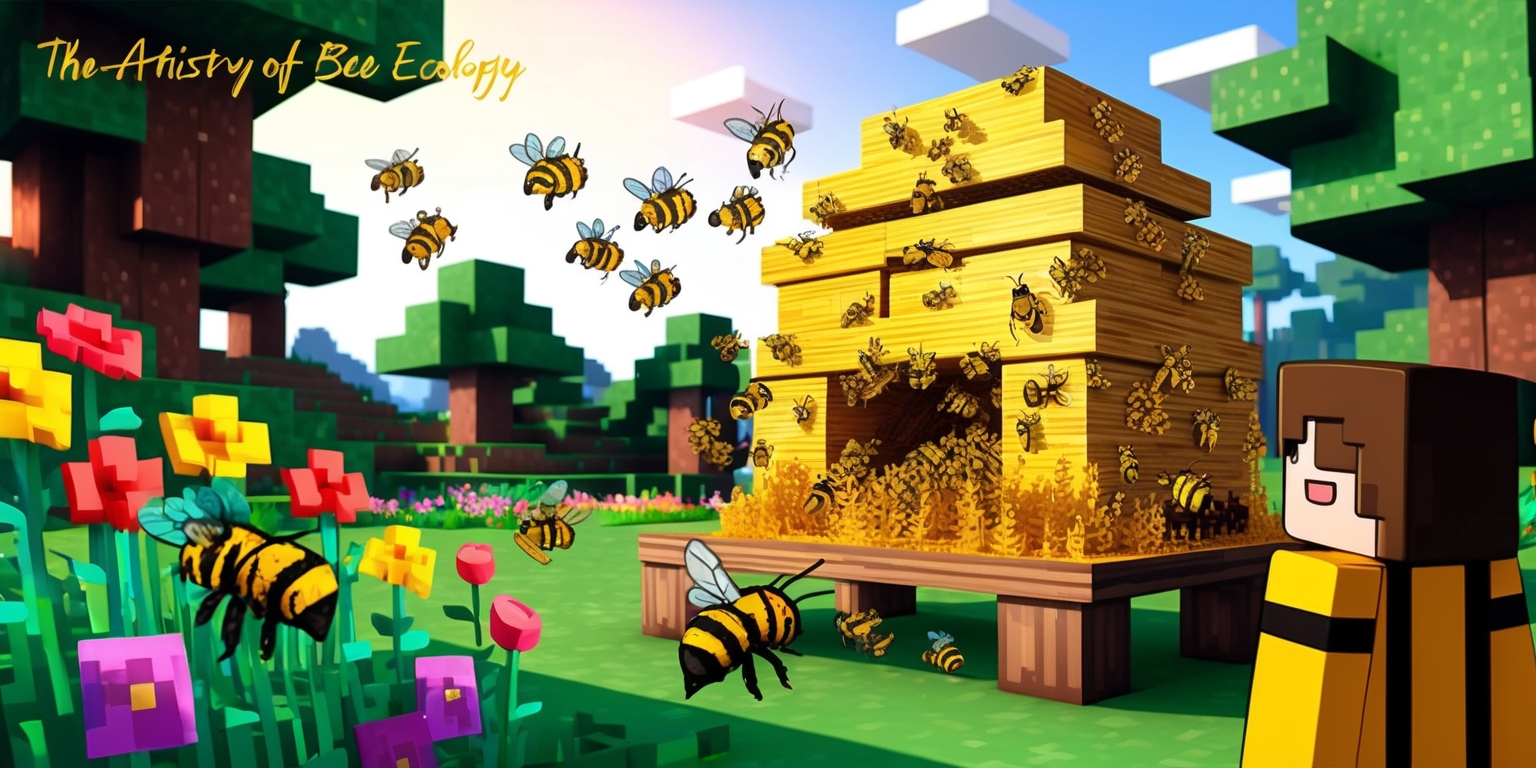 2025-08-24 05:08:52
2025-08-24 05:08:52 The Artistry of Bee Ecology: Unlocking Minecraft's Natural Wonders
The vibrant realm of Minecraft is filled with hidden marvels, one of which is the enchanting world of bees. These tiny, industrious residents of the game not only add a splash of life to nature but also contribute significantly to the growth of your crops. Their gentle buzzing and careful pollination process play a crucial role in transforming the game environment. Minecraft bees, designed to mimic the real-life counterparts, introduce layers of gameplay; from obtaining useful resources like honey and honeycomb to establishing elaborate farming techniques. This immersive experience invites passion for exploration and resource management, ensuring that every encounter with these creatures It offers the same blend of insightful details and enjoyable charm.
The Intricate Role of Bees in Minecraft Ecosystems
Minecraft bees serve as essential actors in the game’s ecosystem. Unlike other creatures that prefer isolation or aggressive behavior, bees remain friendly unless disturbed. They venture out from their nests during the day, seeking flowers to gather pollen, a process that resonates with their real-world nature. As they accomplish this task, bees help fertilize various in-game crops such as wheat, potatoes, carrots, and more. The less conventional approach to nourishment and crop growth adds a strategic twist when compared to traditional farming methods. Players must plan the placement of flowers near crops to maximize pollen yield. This degree of synergy between bees and the environment encourages thoughtful design in garden or farm setups, enhancing both produce yields and the aesthetic appeal of the Minecraft world.
Diverse Habitats for Bee Nests: Finding Nature's Beacons
In the sprawling realms of Minecraft, bee nests appear naturally in different biomes with varying frequencies. When trees like birch or oak emerge in nature, there is a possibility that a bee nest might be integrated into the tree structure, depending on the surrounding environment. Certain biomes such as the meadow exhibit a complete guarantee of bee nest presence, while others, like the plains and mangrove swamps, offer a modest percentage chance. This variability challenges players to explore and identify the most promising landscapes. Moreover, lesser-known regions like cherry groves add an extra layer of discovery, albeit with undisclosed probabilities. This careful distribution of bee nests promotes exploration and rewards players who invest time in understanding the biome-specific details, allowing them to integrate natural resources into their gameplay strategies effectively.
Acquiring and Crafting Bee Nests: A Crafting Adventure
There are several methods to obtain bee nests in Minecraft, catering to players who relish the crafting experience. While bee nests spawn naturally with a small cluster of bees, players can also harvest them using tools. The game offers a unique mechanic wherein using a tool enchanted with Silk Touch enables the collection of a bee nest while ensuring the bees remain safely enclosed. Utilizing an unenchanted tool, however, liberates the inhabitants, who then become agitated. Additionally, creative players can construct new beehives, integrating resources like honeycomb and wooden planks gathered through diligent exploration and in-game farming. This mechanic not only underscores the importance of resource management but also encourages experimentation. By mastering the delicate art of bee nest retention and crafting, players can turn a simple survival tactic into a robust farming enterprise, marrying both aesthetic charm and practical utility.
Capturing the Dance of Pollination: Bees at Work

The pollination process exhibited by Minecraft bees is Just as captivating and indispensable to the… game’s environmental dynamics. During daylight, bees embark on a personal quest, fluttering from one flower to the next in search of pollen—a resource that ultimately aids in crop fertilization. This natural behavior is evident as bees visibly accumulate pollen on their bodies, marking a successful collection process. Once laden with pollen, their return journey to the hive or nest becomes instrumental in transferring the collected particles to various plants. This not only boosts the rapid growth of crops but also mimics the efficiency of using growth accelerators in conventional farming methods. The interplay between bees and plants creates a symbiotic relationship, enhancing the vitality of the Minecraft world. It is this graceful choreography that adds depth and dynamism to the overall gaming experience.
Harvesting Nature’s Sweet Rewards: Honey and Honeycomb
One of the most delightful aspects of interacting with bees is the collection of their delicious byproducts—honey and honeycomb. For players aiming to harvest these resources without aggravating the local bee population, the key lies in preparation. It is essential to set a campfire beneath the beehive, which diffuses smoke and maintains the bees’ calm demeanor during the extraction process. With a carefully placed glass bottle or shears in hand, the player can then extract honey or honeycomb with minimal risk. This harvesting process demands careful timing—observing the nest carefully until it displays a noticeable oozing effect indicates that it is ready for collection. Such attention to detail adds a layer of responsibility and strategy. Additionally, the extraction methods vary depending on the chosen tool, further highlighting the game’s emphasis on employing the optimal approach for maximum benefits.
Mastering the Art of Bee Breeding
Bees in Minecraft are not just one-time resources; they are dynamic entities that can be bred to ensure a continual supply of honey, honeycomb, and effective pollination. The breeding process is relatively straightforward—players simply need to feed a pair of bees nearby their natural habitat. When both bees receive the appropriate type of flower, they enter a special mode that results in the creation of a baby bee. This process is crucial for the maintenance of the bee population, particularly for players interested in establishing extensive farming or decorative operations featuring these creatures. However, It is essential to recognize that there exists a cooldown period of several minutes before the parent bees can engage in breeding again. Effective management and scheduling of bee breeding cycles become fundamental, especially when planning resource production and ensuring the longevity of a thriving pollination environment.
Bee Interaction with Environmental Elements
Minecraft bees exhibit intriguing interactions with various elements of the game world, where timing and placement are everything. During the daytime in the overworld, bees consistently return to their nests when it rains or once nightfall sets in. This predictable behavior helps players strategize visitation and resource gathering. Conversely, bees behave differently in Alternate dimensions, including realms like the Nether and the End, where the usual day-night cycle does not apply. In these realms, bees remain active without pause, continuously engaging in their pollination and honey-making processes. This consistent activity allows players to benefit from an uninterrupted cycle of resource production. The varying behaviors based on environmental conditions underscore the complexity of the game’s design, encouraging players to adapt their strategies and resource management techniques according to They find themselves immersed in an environment that shapes their experience.
Visual and Aesthetic Appeal: The Design of Bee-Related Structures
Minecraft’s attention to detail is reflected remarkably in the design of bee structures, including the nests and hives that serve as focal points in many natural landscapes. The visual transition of a beehive, as it gradually fills with golden honey, adds a tactile charm to the game environment. Designers have ensured that these aesthetic elements not only look appealing but also signal important gameplay mechanics. For instance, the distinct appearance of a bee nest oozing honey is a clear indicator to the diligent player that it is time to harvest. Furthermore, the architectural style of crafted beehives, which blends wooden planks with honeycomb accents, offers a rustic yet tasteful appeal. This dual functionality of serving both as a decorative piece and as a functional resource hub deepens the overall experience, uniting artistry with immersive gameplay dynamics.
Utilizing Tools and Enchantments to Enhance Efficiency
Tools and enchantments in Minecraft play a pivotal role in optimizing interactions with bee-related structures. Players aiming for a seamless harvesting experience must equip themselves with specific enchanted tools. The use of Silk Touch, for instance, is critical when moving a beehive intact, ensuring that the bees remain safely inside the structure during relocation. This crucial detail prevents the accidental release of bees and maintains the organized functioning of bee colonies. Additionally, the pragmatic use of a campfire beneath the hive not only safeguards the player but also ensures that the extraction of honey and honeycomb is conducted calmly. The requirement to use specialized tools infuses the game with an additional dimension of complexity, where precise item selection and proper tool management become indispensable aspects of the strategic gameplay. These mechanics reward players who are meticulous in preparing their inventory and planning their actions.
Transferring Bee Colonies Across Dimensions
The versatility of Minecraft bees is further demonstrated by their adaptability to different dimensions. While they thrive naturally in the overworld, players have the option to introduce bee colonies into more challenging Alternate dimensions like the fiery Nether and the enigmatic End. This transition is not merely a relocation but a strategic move that allows bees to function continuously due to the absence of a typical day-night cycle. Such characteristics open up innovative possibilities for constructing permanent farming systems in unusual settings. As bees continue to operate unabated in these realms, they contribute to sustainable resource production, providing players with steady supplies of honey and aiding in crop fertilization. This adaptability highlights the game’s intricate layer of design, where even the smallest mob is empowered with functions that can transcend environmental boundaries and enhance strategic gameplay approaches.
Managing Bee Behavior for a Smooth Gameplay Experience
Understanding and managing the behavior of bees is A crucial factor in achieving a seamless and efficient integration enjoyable gameplay experience. When interacted with properly, bees perform their roles efficiently, buzzing about to gather pollen and facilitate crop growth. However, any sudden disturbance—whether during resource collection or accidental interference—may trigger a state of agitation among the local bee population. This reaction is visibly marked by changes in the bees’ demeanor, making it crucial for players to adhere to safe harvesting practices. Strategies such as the preventative use of a campfire and effective timing when approaching a hive are indispensable for maintaining order. Players learn to appreciate the balance between engaging with these creatures for resources and preserving their natural order, ultimately forging a deeper connection with the dynamic ecosystems found within Minecraft.




Leave a comment
Your comment is awaiting moderation. We save your draft here
0 Comments